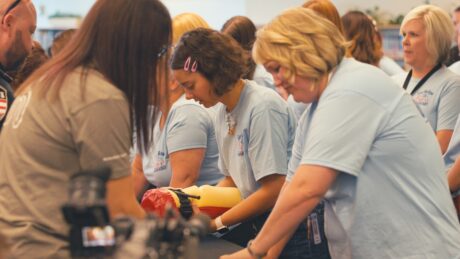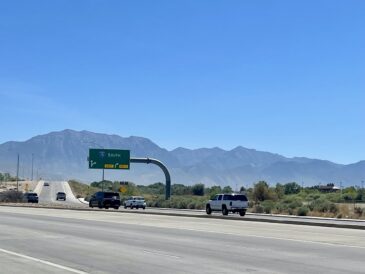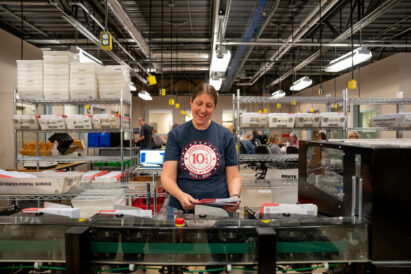Utah’s gun laws and the factors at play as prosecutors mull charges after ‘No Kings’ shooting
Utah gun, self-defense law experts weigh in on Salt Lake City shooting that killed an innocent bystander

Spenser Heaps for Utah News Dispatch
Flowers and pictures are left at a memorial to Arthur “Afa” Ah Loo on Wednesday, June 18, 2025, at the site where he was shot and killed at the “No Kings” protest on State Street in Salt Lake City.A man is dead. One man who was arrested is now out of jail. And the man who allegedly shot three bullets — including the one that killed “innocent bystander” Arthur “Afa” Ah Loo, according to police — is cooperating with law enforcement but is not in custody.
Based on what’s been reported so far in the wake of the chaotic shooting during a “No Kings” protest in Salt Lake City earlier this month, Utah gun law experts say the tragic situation is looking increasingly legally nuanced. And they say it’s possible any justice for Ah Loo and his family may be more likely to come from a civil lawsuit than a criminal case — but that remains to be seen.
“There was, from what it sounds like, a misunderstanding, which led to extremely tragic consequences,” said Clark Aposhian, chairman of the Utah Shooting Sports Council and a Utah gun law lobbyist.
According to Salt Lake City police, the shooting during the June 14 protest happened after two men, who described themselves to police as “peacekeepers,” confronted 24-year-old Arturo Gamboa, who was openly carrying an AR-15 style rifle during the protest. One of the men, reportedly part of the event organizer’s volunteer security team, told police he thought Gamboa was acting suspiciously, which led him to fire three shots from a handgun, hitting Gamboa in the back but also inadvertently striking Ah Loo, who was later pronounced dead at a hospital.
Shortly after the shooting, police arrested Gamboa, and he was booked into jail for investigation of murder. Police say, however, that Gamboa did not fire his rifle, and his attorney said his rifle was not loaded. The two “peacekeepers,” who wore high-visability vests, were initially detained by police, but were released after being questioned. Police said the man who fired the three shots is cooperating with investigators.
Last week, Gamoba was released from jail after the Salt Lake County District Attorney’s Office conducted a preliminary review of evidence. While the investigation continues, charges have not been filed in the case, against either Gamboa or the unnamed armed security volunteer.
While police and protest organizers have not released the identity of the security volunteer, Utah 50501 said he is a military veteran and that members of the safety team were chosen for “military, first responder, and other relevant de-escalation experience.”
The national 50501 organization has disavowed the Utah chapter in the days following the shooting, pointing to a “strict no-weapons policy” for the groups it affiliates with. Salt Lake’s demonstration, which drew 10,000 people, was part of a national wave of protests that day criticizing President Donald Trump’s leadership and policies.
To Aposhian, Utah’s nonrestrictive gun laws may offer protection for both Gamboa and the armed security volunteer who fired.
“You know, my gut (feeling) is nobody’s going to be going to prison on this,” Aposhian said, adding that prosecutors likely face a “heavy bar” to prove beyond a reasonable doubt that Gamboa had malicious intent by openly carrying the AR-15 or was acting recklessly leading up to the shooting.
Utah’s gun and self-defense laws and the factors at play
Utah is a “constitutional carry” state, meaning its laws allow the open and concealed carrying of firearms without a permit for those 21 years old and over who are legally allowed to possess them. Plus, those ages 18 to 20 can carry a concealed firearm in public if they obtain a provisional concealed carry permit.
Utah also has one of the “strongest” self defense laws in the country, said Mitch Vilos, a Utah attorney with expertise in weapons law and the author of a book comparing self-defense laws across all 50 states. Utah law allows the use of force, including deadly force, when a person reasonably believes it’s necessary to prevent death, serious bodily injury, or forcible felony. Utah is also a “stand your ground” state, meaning a person does not have a duty to retreat before using force in self-defense, including in public places.
The details that will likely decide a potential criminal case or a civil lawsuit will likely come down to two things — intent and behavior — leading up to the shooting.
“Unless there’s something that shows Gamboa … had some sort of a manifesto or something,” Vilos said, then it’s likely prosecutors won’t be able to prove any sort of malicious intent on his part. And the “No Kings” demonstration reportedly wasn’t the first protest where Gamboa has openly carried that AR-15 style rifle. His friend and longtime roommate told The Salt Lake Tribune he’s brought it to protests at least a dozen times before, and never aimed it at anyone.
And as for the armed security volunteer, “if he reasonably thought that a mass murder was in progress” in the moments before shooting and if prosecutors can’t provide “clear and convincing evidence that (his decision to shoot) was not self-defense or self-defense or another,” then a criminal case would likely be dismissed, Vilos said.
“You know, (it seems) you have two people with good intentions, and to me it just doesn’t seem productive to bring a criminal case against either one of them,” Vilos said. “I think it’s more of a friendly fire incident than it is a case where you’ve got someone that’s acting violently towards someone with no good cause.”
The self-described “peacekeeper” told police, according to an affidavit of probable cause for Gamboa’s arrest, that Gamboa had “lifted the rifle,” and witnesses said he had begun running toward the crowd while holding it in a “firing position.”
But in the days since Gamboa’s arrest, videos have circulated online raising questions about whether Gamboa had actually raised the rifle in a firing position or charged the crowd. One video angle, reported by FOX 13, showed Gamboa with his rifle pointed down and not running until after one of the security volunteers started shooting.
Aposhian said it’s possible that prosecutors could argue the armed security volunteer acted negligently or recklessly.
“If you’re acting in self-defense, and you shoot and your bullet overpenetrates, or richochets, or it misses its mark and it hits an innocent party, you’re not going to be criminally liable unless it can you can be found that you acted with negligence or reckless disregard,” Aposhian said. “It’s an unintentional type of thing, but they’re going to have to show that you acted with reckless disregard.”
Additionally, Aposhian noted that acting in self-defense “certainly does not necessarily protect you from a civil suit.”
Evidentiary standards in civil lawsuits have much lower thresholds than in a criminal case, both Aposhian and Vilos said.
“In a criminal case, it’s beyond a reasonable doubt, and in civil it’s whatever tips the scales, a preponderance of the evidence,” Aposhian said.
Vilos said depending on potential insurance coverage for the victim or the men involved, “there’s probably a chance for a significant civil settlement.” But insurance coverage could hinge on what happens with criminal charges, if there are any.
“If anybody really cares about the family (of the victim), the best thing that could happen would be a civil lawsuit that’s successful, and to heck with the criminal action because it’s probably going to be a loser, and it’s going to take a lot of resources,” Vilos said. “And it could actually harm the ability of the family to collect a civil damage award.”
Should Utah allow open carry of long guns during protests?
Unlike 26 other states, Utah has not adopted a law prohibiting the open carrying of long guns at state capitols or political protests, according to Everytown Research & Policy, an organization that produces research on gun violence and advocates for gun violence prevention. The group has ranked Utah as No. 36 in the country for “gun law strength.”
When asked whether lawmakers would be open to considering some type of policy change to restrict the open carrying of long guns during protests given what happened during the Salt Lake City “No Kings” protest, House Speaker Mike Schultz told reporters last week “Utah is a very proud Second Amendment state.”
“Finding that balance is what we want to try to do, and I think we’ve done a good job with it in the past,” he said.
Schultz, however, left the door open to a discussion.
“As we enter into the legislative session and we have more details around what happened, I’m sure some of those conversations will happen and we’ll see where it goes from there,” Schultz said.
Aposhian — who has been lobbying for Second Amendment rights for 30 years — acknowledged that carrying a gun openly, especially a type of gun “that has been demonized, an AR-15, it’s very provocative.”
“And anything you do will be viewed through the eyes of someone who may or may not appreciate AR-15s,” he said.
Aposhian added that today’s polarized political climate — and given that some protests across the country have turned violent — can contribute to tensions.
However, Aposhian added that the open carrying of firearms “is and always has been legal in Utah.”
He predicted that any efforts to regulate what type of guns can be carried openly during political protests would be met with resistance from Utah’s Republican-controlled Legislature. And it’s not something that he or the Utah Shooting Sports Council would be supportive of, either.
It would be an “emotional response,” he said. “Emotion really doesn’t make for good laws.”
So while open carrying a gun like an AR-15 rifle may be “provocative,” Aposhian said it’s also a form of exercising two constitutional rights — the right to free speech and the right to bear arms — at the same time.
“Carrying that gun is utilizing both those rights,” he said.
Utah News Dispatch is part of States Newsroom, the nation’s largest state-focused nonprofit news organization.



